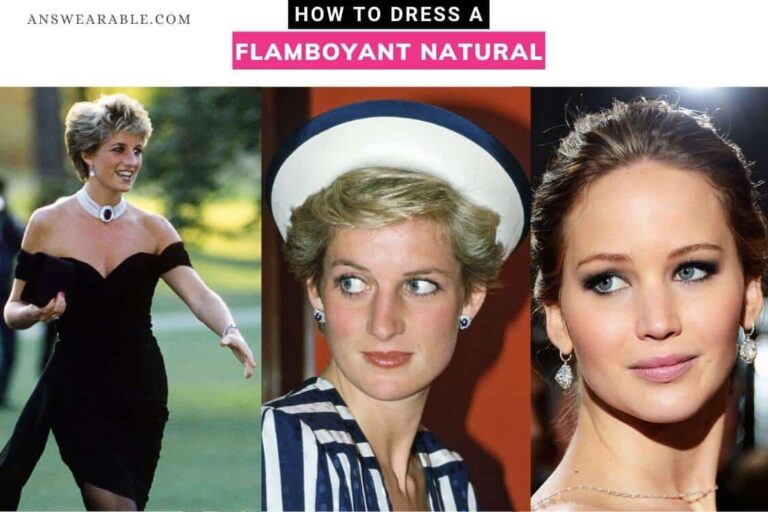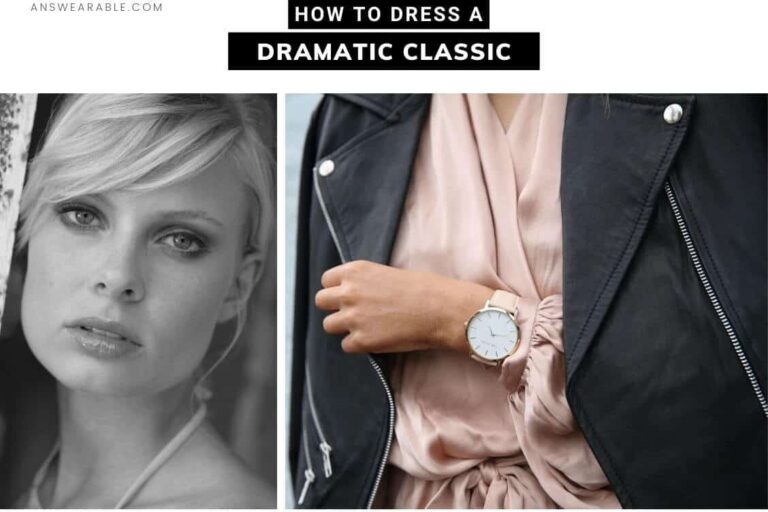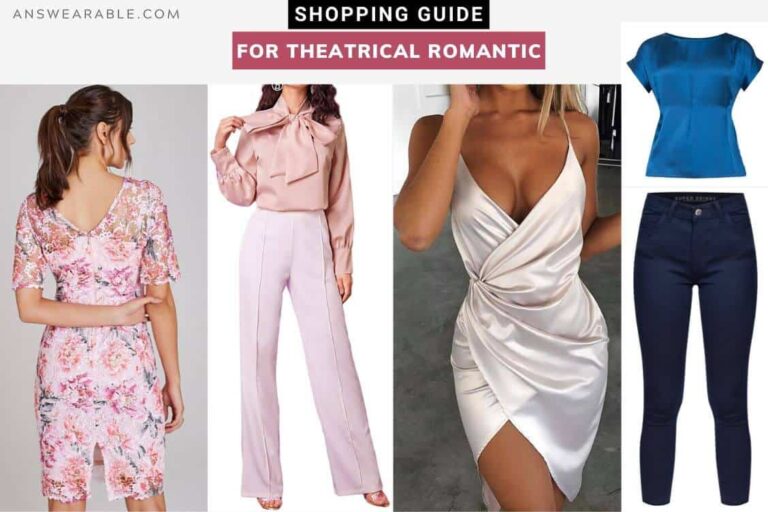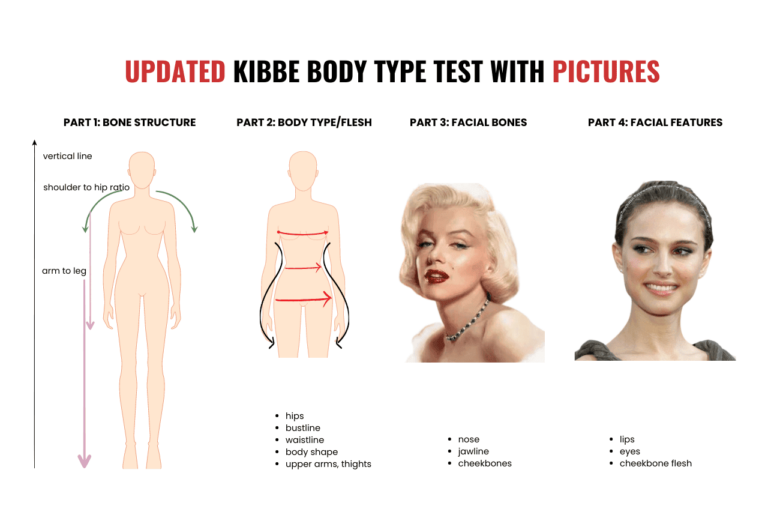In this post, you’ll learn how to dress a Classic body type— the most balanced and symmetrical of all Kibbe body types. By learning the principles, you’ll know exactly how to put together outfits that’ll fuse harmoniously with your even silhouette.

Instead of worshiping trends and wearing what everybody else is wearing, you’ll finally call the shots. You’ll be able to judge each trend objectively and see if it honors your silhouette. From there, you can decide whether to incorporate a certain trend or veer off it completely— and actually know why. Here’s how to dress a Classic body type.
What makes a Classic body type?
To classify as a Classic, your answers to the Kibbe test should mostly be C under all three sections (Skeleton, Body Flesh, Facial Features).
Having a Classic body means that the primary adjective that describes your whole body is balanced and even— not tall, nor wide, nor curvy. You can’t be super tall (more than 5’7″) and be a Classic. Nor are you a Classic if your curves are extremely defined. Otherwise, it would cancel out the balance and would no longer be Classic.
You can, however, be petite and be Classic. But even then, your primary adjective should still be balanced more than petite. In short, nothing cancels out balance. The key is the unmistakable symmetry and evenness.
Confused about what’s Yin and what’s Yang? This article should help: Yin vs Yang Examples of Kibbe Body Types.
Skeleton (bone structure):
- symmetrical, with tendency toward slight sharpness
- slightly angular
- slightly straight
- tapered shoulders
Facial Features (facial flesh and bones):
- symmetrical
- chiseled facial structure
- evenly spaced facial features
Body Flesh (bust, waist, hips, thighs, upper arms)
- not straight nor very curvy but balanced
- evenly proportioned bust, waist, and hips.
- slightly lithe and sinewy musculature
- moderate to slightly long limbs
A Classic will not:
- have an hourglass figure
- be super tall (above 5 feet 7 inches)
- be extremely petite and delicate
- have full, lush, facial features (very rounded eyes, fleshy cheeks, and full lips)
Classic celebrity examples
One of the Kibbe-verified classic celebrities is Isabelle Huppert. At first glance, you might think she’s a Dramatic because of her angular jawline. But if you look closely and compare her jawline to the rest of her facial features (cheekbones especially), you can see that she’s too symmetrical to be a Dramatic.
Remember: Classic faces are chiseled yet they scream symmetry.
Her eyes are neither very rounded to be a Romantic, nor very narrow to be Dramatic or a Natural. Her lips are definitely fuller than Dramatic and Natural but also thinner than Romantic.
Her cheek flesh is neither very taut nor very fleshy. Lastly, her cheekbones are definitely not as high and as prominent as that of a Dramatic. When you look at her face, the first thing you notice is the unmistakable symmetry and evenness.
If you look at the body of a Classic, you’d see a blended mix of Yin and Yang. Although they have curves, they’re definitely not as voluptuous and rounded as Romantics. Their shoulders and hips are also of the same visual width.
The same applies to these following Kibbe-verified celebrities:
Diane Sawyer
Ginger Rogers
Cybill Shepherd
How to Dress a Classic Body Type
Now that you know what makes a classic body, it’s time to learn the principles of styling it. So how do you style a Classic body type?
The best way to dress your classic body is to follow your own lines. For a Classic like yourself, this means wearing outfits that hug your silhouette or stay close to your body.
You wanna avoid voluminous embellishments as they’ll only overpower and bury your silhouette. You also don’t wanna wear severe and sharp outlines. Moderation is key. You can have a little bit of everything but never too much. Take a look at these examples:
1. Honor your symmetry.
If you find yourself wishing that your butt were bigger, your waist curvier, and your boobs larger, stop right now.
Most fashion tips may tell you that whatever you “lack”, you compensate through clothing. But see, there’s nothing to compensate. You’re perfect as you are. And no, that’s not a cliche.
When a Classic wears a piece meant to “compensate” for what she’s apparently lacking, she looks like an overkill, a try-hard.
But when she wears an ensemble that honors her symmetry and evenness (while ignoring the rules that women should always have large butts and curvy waist), she shines. She complements her silhouette and she’s in harmony with it. As a result, she creates an effortless, aesthetically pleasing ensemble.
Take a look at this outfit of Isabelle Huppert.
Everything about the dress is calm, controlled, and collected. The sharpness (Yang) is present but it’s modest. The soft draping (Yin) is noticeable but it isn’t screaming. We know the belt is there but it definitely isn’t the center of attention. Overall, the whole point of the outfit is not to vie for attention but to honor her symmetry.
You might think that every woman can never go wrong with a an extra lump of butt and boobs. However, that’s not the case with a Classic at all.
The problem with wearing voluminous pieces to make your boobs and bum look larger is that you’re creating a disharmony in the outfit. It becomes one of those moments when you know something is wrong with the outfit but you can’t quite figure out what.
2. Keep the detail clean, simple, and minimal.
Ensure that each detail of your outfit never call attention to itself but instead contribute to the smooth visual line of your outfit. As a Classic, do remember that it’s easy to be overpowered by bold prints and embellishments.
This does not mean you should only wear monochromatic and solid colors. You can still wear prints and details but they’re best when their patterns are repeating and coherent and if they’re moderately sized instead of oversized.
3. Don’t overdo waist emphasis.
While waist definition should always be present in a Classic ensemble, it should remain understated (think narrow, elegant belts or ties). A Classic looks best in a soft waist definition. Shirtwaists, softly tailored wrap dresses, soft sheaths, smooth knits, and belted coatdresses are great. Avoid super tight, rounded pieces just for the sake of making your waist look narrower. It will only look overdone on you.
4. Best makeup for a Classic
Pure Classic Shopping Guide
Looking for an exclusive shopping guide for Pure Classic? This article will show you how to shop for pieces from head to toe: from clothing, accessories, makeup, coloring, and prints.
You Might Also Like:







Hi I am confused if I am dramatic or classic these are my answers A: 4 b:3 c: 5 d: 4
This makes me a classic but I only have more c’s than a’s because I couldn’t decide if my head was smaller or proportionate to my body! Anyone have any advice?
Hi,
I am 9-c, 5-a and d-2, i am confused between dramatic classic or classic.
The results say that I should be dramatic classic but i feel that i am a classic. I am really confused.
Hi, when I tried the test the answers pointed towards classic, but I am quite unsure as I can’t see myself as being ‘symmetrical’ I definitely have a pear shape, not extremely but slightly bottom heavy, with bust and waist being proportioned and defined slightly ( not straight line) and smallish arms and shoulders. Head larger in proportion to the body, as for the facial features, mouth is rather small, eyes average and nose is more prominent but not sharp or too round (however the size seem okay for the face). Another confusing aspect is that people describe me as childish looking. I would be really glad for any help <3
Just by glancing at your picture I’d say you are a classic. I am also a classic with a heavier bottom and narrower shoulders, but my breasts have had a growth surge since I turned 24, which has me looking more like a soft classic if you focus too hard on this aspect, but overall I stand pretty much on the middle, with very yin and yang characteristcs. Just remember – you are not a sample, you are a person. This is meant to help you, not fit you in. If your overall result says you are a classic, that’s probably true.
I don’t know your height but it’s okay to be slightly bottom heavy, the question is whether or not your lower half is curvy enough to be eye-catching. I think one of the most succinct ways to describe a classic is that nothing really stands out: they don’t look very curvy, or athletic; they don’t look like very obvious apples or pears, but actually can be either/or. Everything is pretty ‘average.’
From a quick glance at your picture though I would say you lean dramatic classic. I think there’s a slim-ness to your features, like your nose and smallness of the mouth that are more yang, but still this can exist within a classic woman.
Hi,
I’m quite confused with my answers and I was wondering if you could give me any advice.
Overall, I scored 9C, 3B,2D,1 a and 1e.
My bone structure is equal number of C and B, my body flesh is primarily C (3) with some Yang tendencies (1 answer from A and B), but my facial features are primarily C (4) but the remaining answers are D (2) and E (1).
From the result explanation, it seems I should be a classic dramatic, but I don’t think it applies well to my facial features…
Hi, I got answers d=4, c=7, e=2
Bone structure was d
Flesh was c
Facial bones mostly c
Am I soft classic or classic or something Else?
I am overweight so it’s hard to do The test.
Hi Kati, based on your answers, yes, you’re clearly a Soft Classic. The main indication is that your torso and your lower body should be balanced, not wider/ more prominent than the other — this is the Classic/ balanced part.
You also have an extra roundness as opposed to angularity (this is the Yin or Romantic undercurrent). Overall, you should be balanced first, then Romantic second.
To be classified as a type of Classic, you’d have to be primarily balanced, then either balanced and rounded (for Soft Classic) or balanced and angular (for Dramatic Classic).
Also, pure Classic is no longer an option. Kibbe recently removed pure Classic, pure Gamine, and pure Natural from the options. It’s either you lean on extra Yin or extra Yang. Hope this helps.